Strategic Planning for Cross Border and Global Organizations: Google
VerifiedAdded on 2023/06/10
|20
|4874
|250
Report
AI Summary
This report provides an analysis of inter-organizational strategies in the context of global business expansion, using Google Inc. as a case study. It evaluates the constraints and contributions of such strategies, examining the planning and implementation processes, and assessing the impact of power dynamics among participating organizations. The report also critically compares the missions, goals, strengths, weaknesses, opportunities, and threats of cross-border partners and competitors. Furthermore, it delves into the role of strategic intelligence, cultural differences in strategic planning, and the internal and external impacts of these strategies on organizational policy. The analysis concludes that cross-border strategic management and strategic intelligence are vital for Google's organizational operations despite inherent limitations.

Running Head: STRATEGIC PLANNING
STRATEGIC PLANNING
Name of the Student:
Name of University:
Author Note:
STRATEGIC PLANNING
Name of the Student:
Name of University:
Author Note:
Paraphrase This Document
Need a fresh take? Get an instant paraphrase of this document with our AI Paraphraser
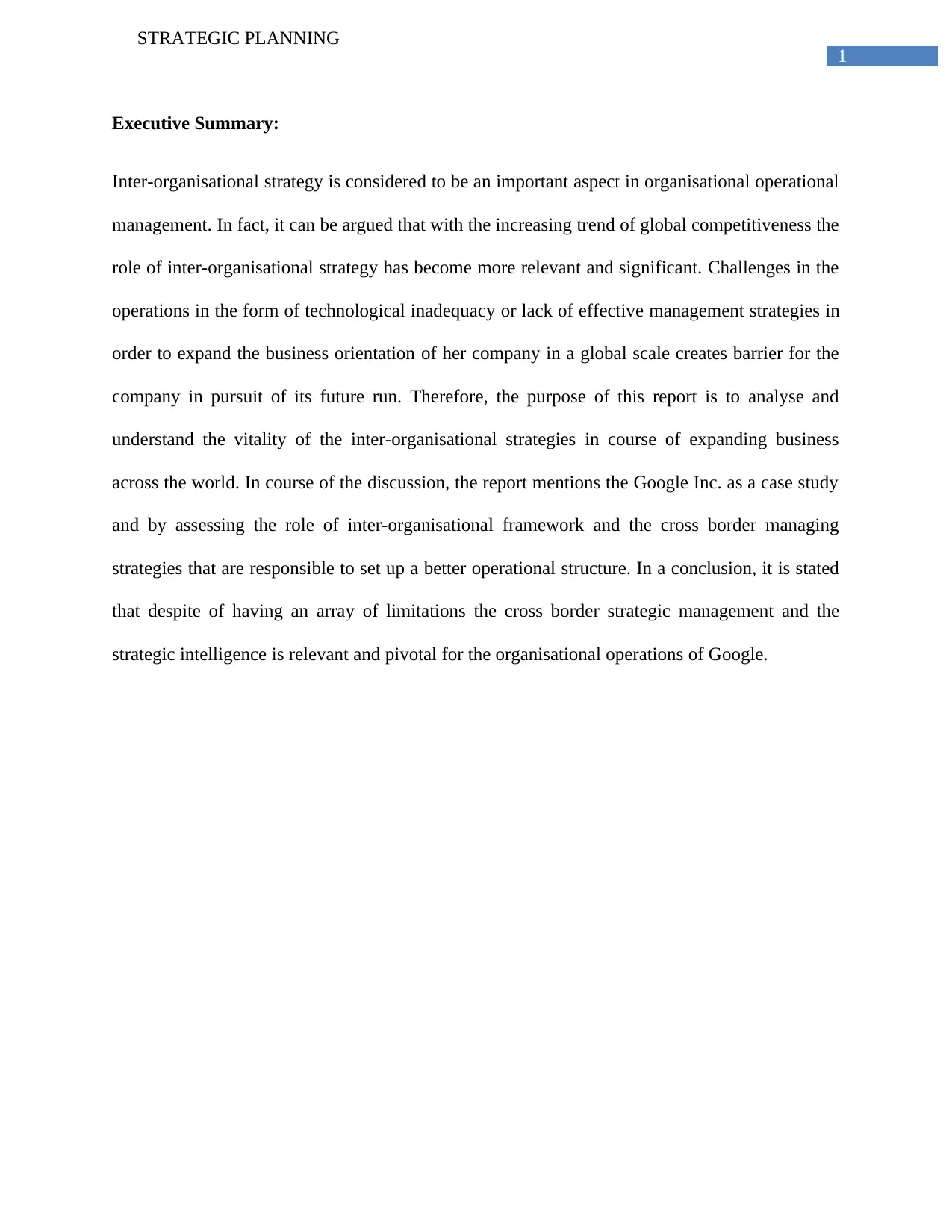
1
STRATEGIC PLANNING
Executive Summary:
Inter-organisational strategy is considered to be an important aspect in organisational operational
management. In fact, it can be argued that with the increasing trend of global competitiveness the
role of inter-organisational strategy has become more relevant and significant. Challenges in the
operations in the form of technological inadequacy or lack of effective management strategies in
order to expand the business orientation of her company in a global scale creates barrier for the
company in pursuit of its future run. Therefore, the purpose of this report is to analyse and
understand the vitality of the inter-organisational strategies in course of expanding business
across the world. In course of the discussion, the report mentions the Google Inc. as a case study
and by assessing the role of inter-organisational framework and the cross border managing
strategies that are responsible to set up a better operational structure. In a conclusion, it is stated
that despite of having an array of limitations the cross border strategic management and the
strategic intelligence is relevant and pivotal for the organisational operations of Google.
STRATEGIC PLANNING
Executive Summary:
Inter-organisational strategy is considered to be an important aspect in organisational operational
management. In fact, it can be argued that with the increasing trend of global competitiveness the
role of inter-organisational strategy has become more relevant and significant. Challenges in the
operations in the form of technological inadequacy or lack of effective management strategies in
order to expand the business orientation of her company in a global scale creates barrier for the
company in pursuit of its future run. Therefore, the purpose of this report is to analyse and
understand the vitality of the inter-organisational strategies in course of expanding business
across the world. In course of the discussion, the report mentions the Google Inc. as a case study
and by assessing the role of inter-organisational framework and the cross border managing
strategies that are responsible to set up a better operational structure. In a conclusion, it is stated
that despite of having an array of limitations the cross border strategic management and the
strategic intelligence is relevant and pivotal for the organisational operations of Google.
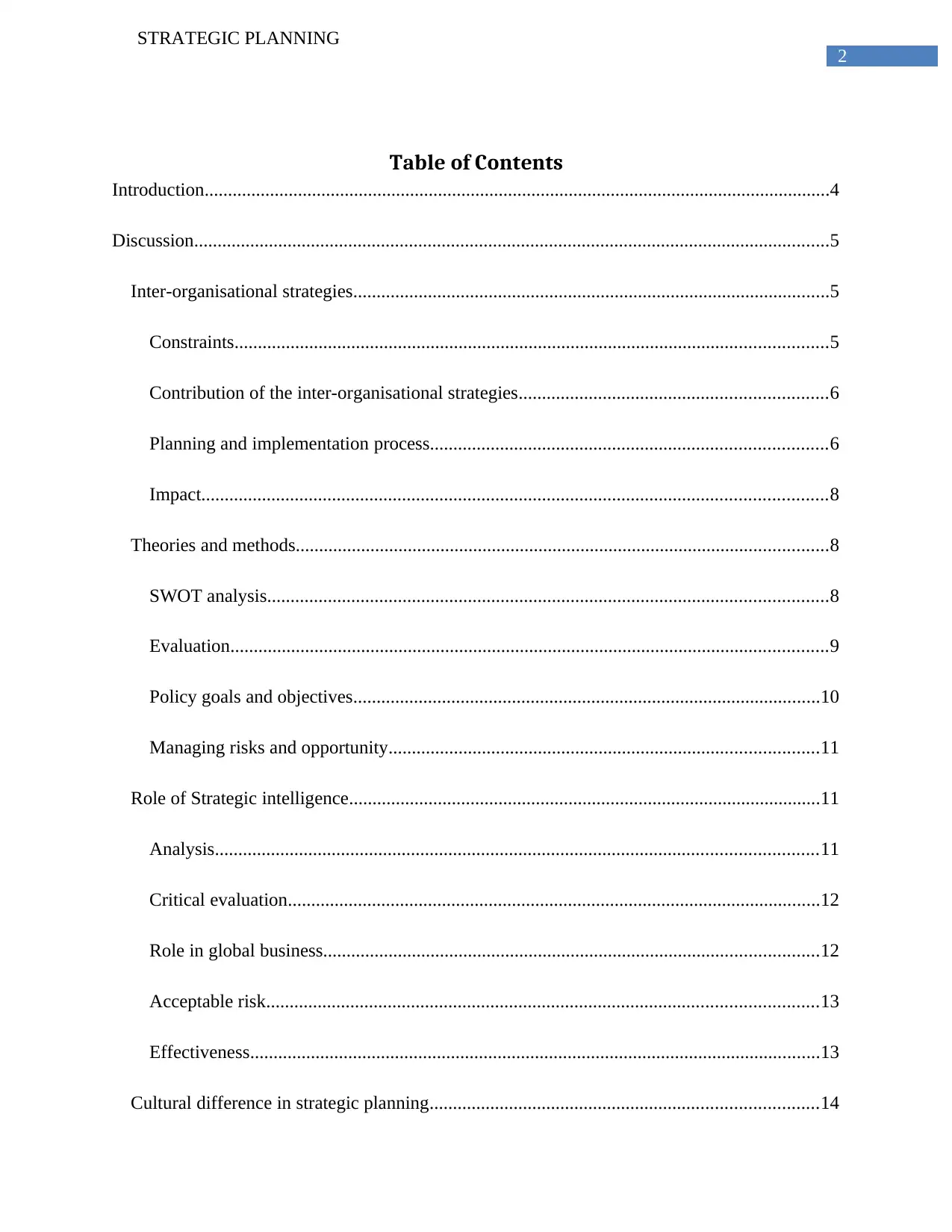
2
STRATEGIC PLANNING
Table of Contents
Introduction......................................................................................................................................4
Discussion........................................................................................................................................5
Inter-organisational strategies......................................................................................................5
Constraints...............................................................................................................................5
Contribution of the inter-organisational strategies..................................................................6
Planning and implementation process.....................................................................................6
Impact......................................................................................................................................8
Theories and methods..................................................................................................................8
SWOT analysis........................................................................................................................8
Evaluation................................................................................................................................9
Policy goals and objectives....................................................................................................10
Managing risks and opportunity............................................................................................11
Role of Strategic intelligence.....................................................................................................11
Analysis.................................................................................................................................11
Critical evaluation..................................................................................................................12
Role in global business..........................................................................................................12
Acceptable risk......................................................................................................................13
Effectiveness..........................................................................................................................13
Cultural difference in strategic planning...................................................................................14
STRATEGIC PLANNING
Table of Contents
Introduction......................................................................................................................................4
Discussion........................................................................................................................................5
Inter-organisational strategies......................................................................................................5
Constraints...............................................................................................................................5
Contribution of the inter-organisational strategies..................................................................6
Planning and implementation process.....................................................................................6
Impact......................................................................................................................................8
Theories and methods..................................................................................................................8
SWOT analysis........................................................................................................................8
Evaluation................................................................................................................................9
Policy goals and objectives....................................................................................................10
Managing risks and opportunity............................................................................................11
Role of Strategic intelligence.....................................................................................................11
Analysis.................................................................................................................................11
Critical evaluation..................................................................................................................12
Role in global business..........................................................................................................12
Acceptable risk......................................................................................................................13
Effectiveness..........................................................................................................................13
Cultural difference in strategic planning...................................................................................14
⊘ This is a preview!⊘
Do you want full access?
Subscribe today to unlock all pages.

Trusted by 1+ million students worldwide
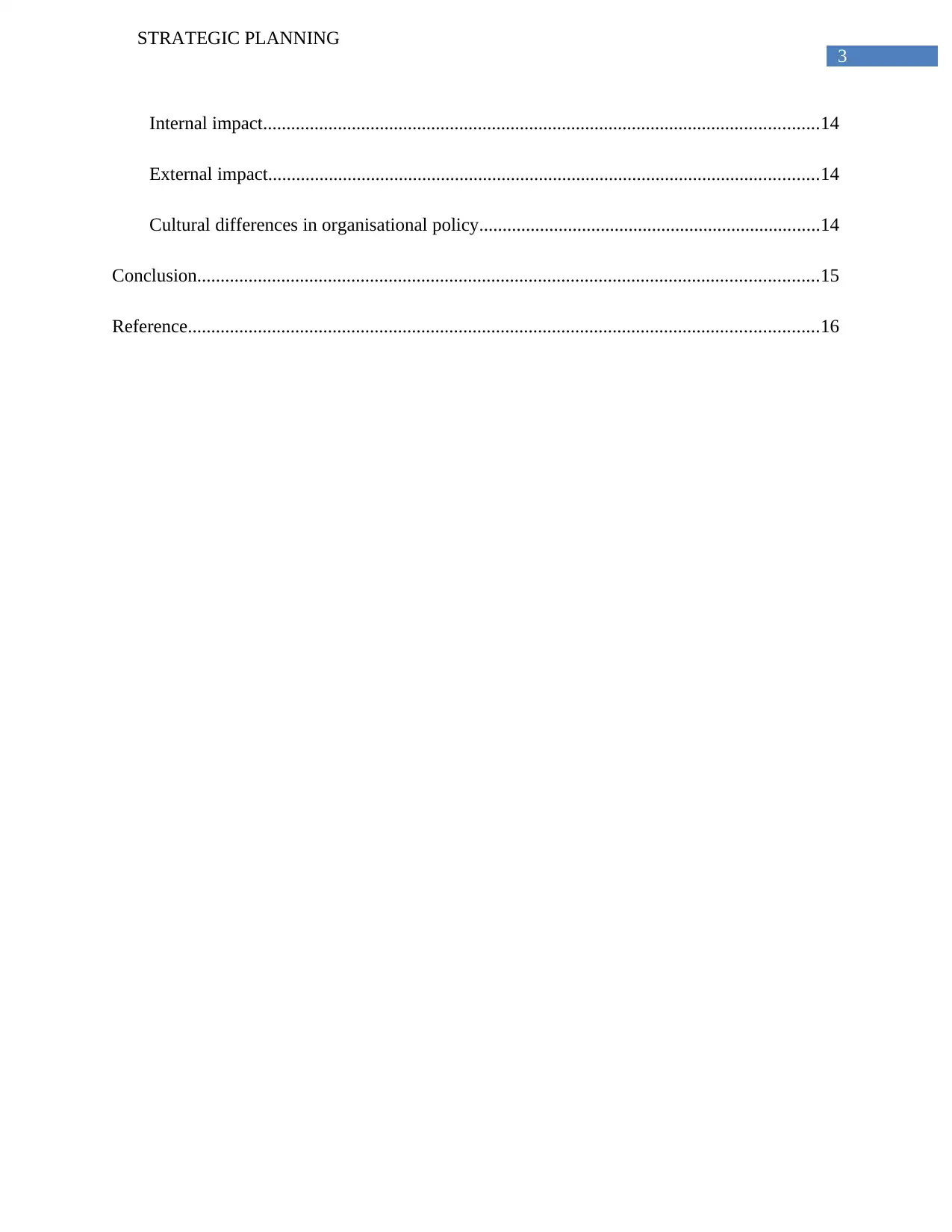
3
STRATEGIC PLANNING
Internal impact.......................................................................................................................14
External impact......................................................................................................................14
Cultural differences in organisational policy.........................................................................14
Conclusion.....................................................................................................................................15
Reference.......................................................................................................................................16
STRATEGIC PLANNING
Internal impact.......................................................................................................................14
External impact......................................................................................................................14
Cultural differences in organisational policy.........................................................................14
Conclusion.....................................................................................................................................15
Reference.......................................................................................................................................16
Paraphrase This Document
Need a fresh take? Get an instant paraphrase of this document with our AI Paraphraser
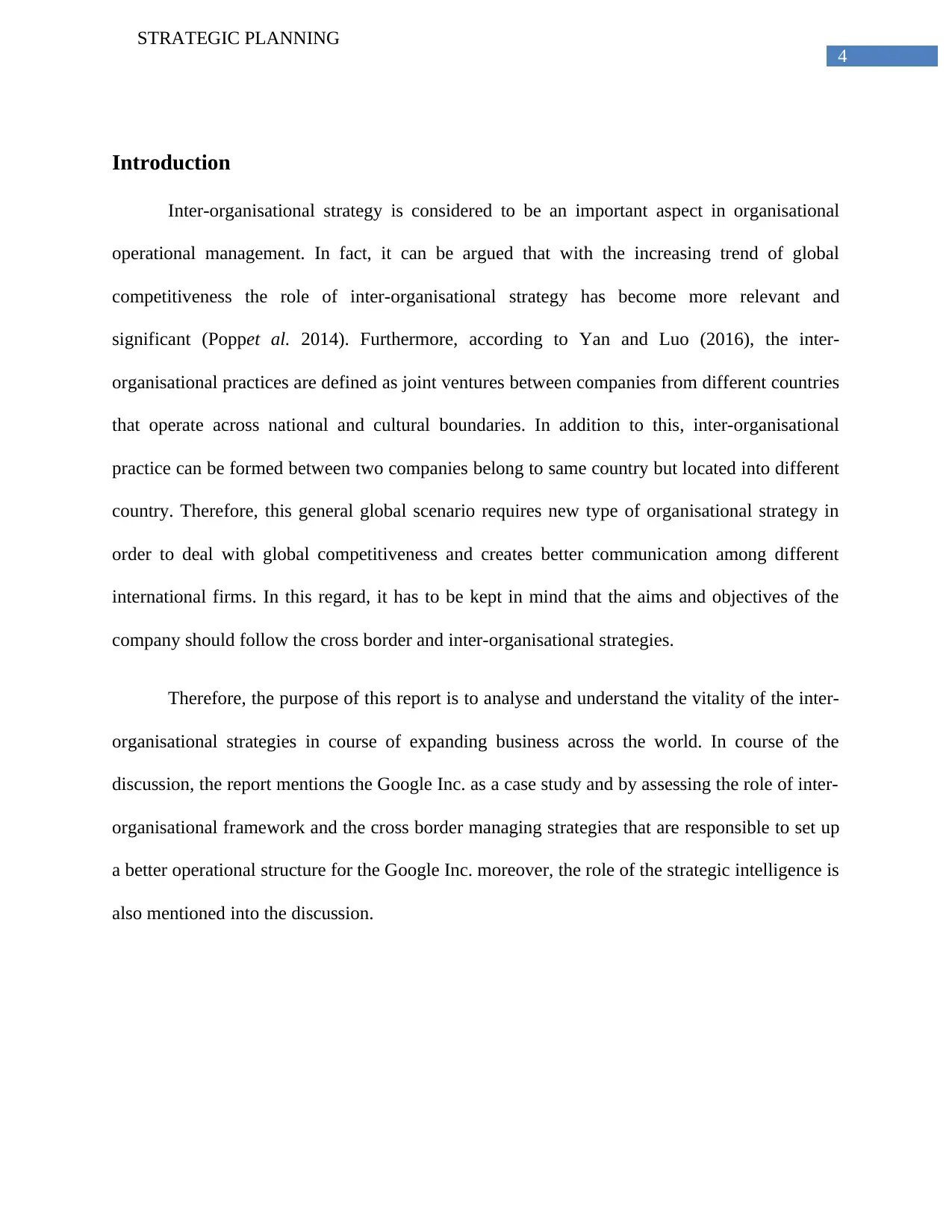
4
STRATEGIC PLANNING
Introduction
Inter-organisational strategy is considered to be an important aspect in organisational
operational management. In fact, it can be argued that with the increasing trend of global
competitiveness the role of inter-organisational strategy has become more relevant and
significant (Poppet al. 2014). Furthermore, according to Yan and Luo (2016), the inter-
organisational practices are defined as joint ventures between companies from different countries
that operate across national and cultural boundaries. In addition to this, inter-organisational
practice can be formed between two companies belong to same country but located into different
country. Therefore, this general global scenario requires new type of organisational strategy in
order to deal with global competitiveness and creates better communication among different
international firms. In this regard, it has to be kept in mind that the aims and objectives of the
company should follow the cross border and inter-organisational strategies.
Therefore, the purpose of this report is to analyse and understand the vitality of the inter-
organisational strategies in course of expanding business across the world. In course of the
discussion, the report mentions the Google Inc. as a case study and by assessing the role of inter-
organisational framework and the cross border managing strategies that are responsible to set up
a better operational structure for the Google Inc. moreover, the role of the strategic intelligence is
also mentioned into the discussion.
STRATEGIC PLANNING
Introduction
Inter-organisational strategy is considered to be an important aspect in organisational
operational management. In fact, it can be argued that with the increasing trend of global
competitiveness the role of inter-organisational strategy has become more relevant and
significant (Poppet al. 2014). Furthermore, according to Yan and Luo (2016), the inter-
organisational practices are defined as joint ventures between companies from different countries
that operate across national and cultural boundaries. In addition to this, inter-organisational
practice can be formed between two companies belong to same country but located into different
country. Therefore, this general global scenario requires new type of organisational strategy in
order to deal with global competitiveness and creates better communication among different
international firms. In this regard, it has to be kept in mind that the aims and objectives of the
company should follow the cross border and inter-organisational strategies.
Therefore, the purpose of this report is to analyse and understand the vitality of the inter-
organisational strategies in course of expanding business across the world. In course of the
discussion, the report mentions the Google Inc. as a case study and by assessing the role of inter-
organisational framework and the cross border managing strategies that are responsible to set up
a better operational structure for the Google Inc. moreover, the role of the strategic intelligence is
also mentioned into the discussion.
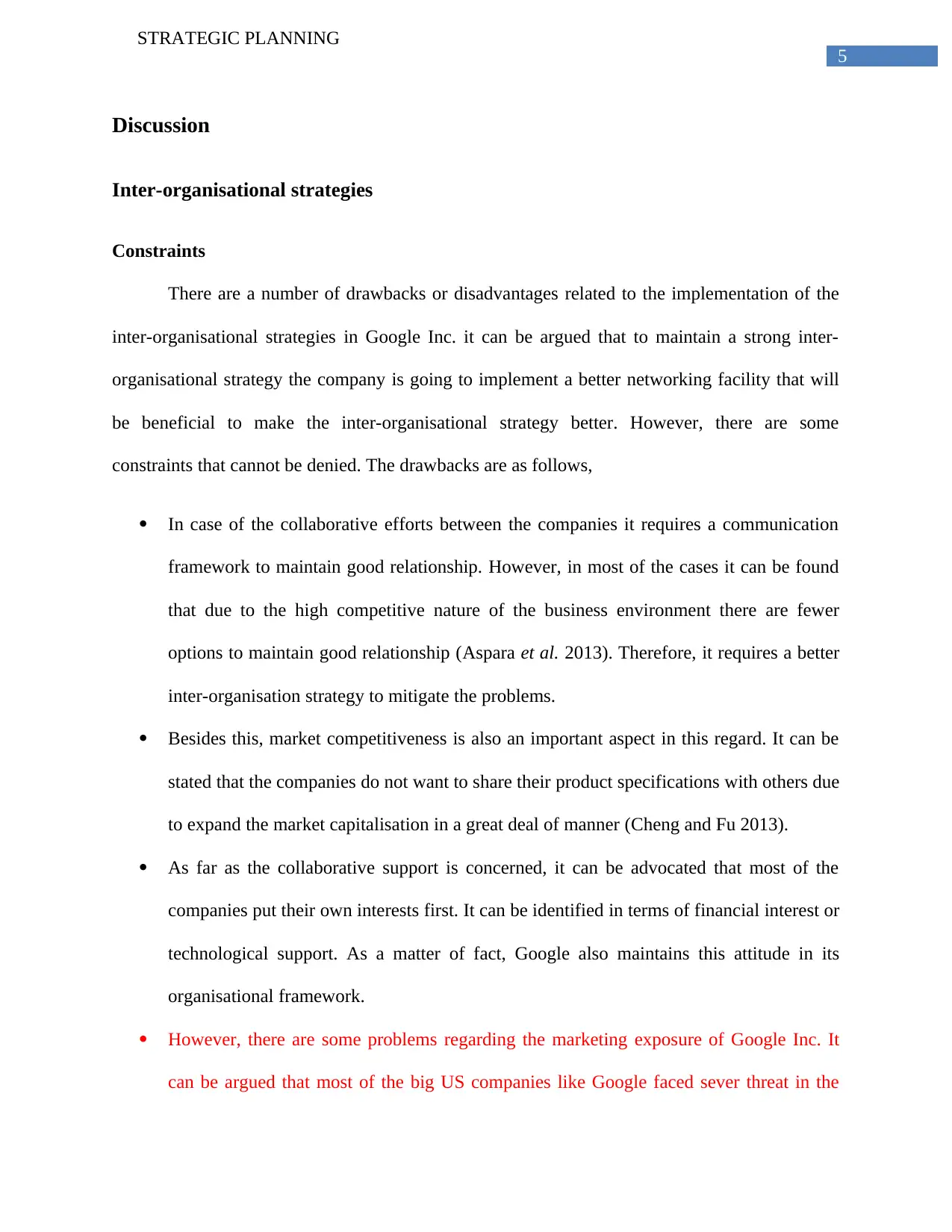
5
STRATEGIC PLANNING
Discussion
Inter-organisational strategies
Constraints
There are a number of drawbacks or disadvantages related to the implementation of the
inter-organisational strategies in Google Inc. it can be argued that to maintain a strong inter-
organisational strategy the company is going to implement a better networking facility that will
be beneficial to make the inter-organisational strategy better. However, there are some
constraints that cannot be denied. The drawbacks are as follows,
In case of the collaborative efforts between the companies it requires a communication
framework to maintain good relationship. However, in most of the cases it can be found
that due to the high competitive nature of the business environment there are fewer
options to maintain good relationship (Aspara et al. 2013). Therefore, it requires a better
inter-organisation strategy to mitigate the problems.
Besides this, market competitiveness is also an important aspect in this regard. It can be
stated that the companies do not want to share their product specifications with others due
to expand the market capitalisation in a great deal of manner (Cheng and Fu 2013).
As far as the collaborative support is concerned, it can be advocated that most of the
companies put their own interests first. It can be identified in terms of financial interest or
technological support. As a matter of fact, Google also maintains this attitude in its
organisational framework.
However, there are some problems regarding the marketing exposure of Google Inc. It
can be argued that most of the big US companies like Google faced sever threat in the
STRATEGIC PLANNING
Discussion
Inter-organisational strategies
Constraints
There are a number of drawbacks or disadvantages related to the implementation of the
inter-organisational strategies in Google Inc. it can be argued that to maintain a strong inter-
organisational strategy the company is going to implement a better networking facility that will
be beneficial to make the inter-organisational strategy better. However, there are some
constraints that cannot be denied. The drawbacks are as follows,
In case of the collaborative efforts between the companies it requires a communication
framework to maintain good relationship. However, in most of the cases it can be found
that due to the high competitive nature of the business environment there are fewer
options to maintain good relationship (Aspara et al. 2013). Therefore, it requires a better
inter-organisation strategy to mitigate the problems.
Besides this, market competitiveness is also an important aspect in this regard. It can be
stated that the companies do not want to share their product specifications with others due
to expand the market capitalisation in a great deal of manner (Cheng and Fu 2013).
As far as the collaborative support is concerned, it can be advocated that most of the
companies put their own interests first. It can be identified in terms of financial interest or
technological support. As a matter of fact, Google also maintains this attitude in its
organisational framework.
However, there are some problems regarding the marketing exposure of Google Inc. It
can be argued that most of the big US companies like Google faced sever threat in the
⊘ This is a preview!⊘
Do you want full access?
Subscribe today to unlock all pages.

Trusted by 1+ million students worldwide
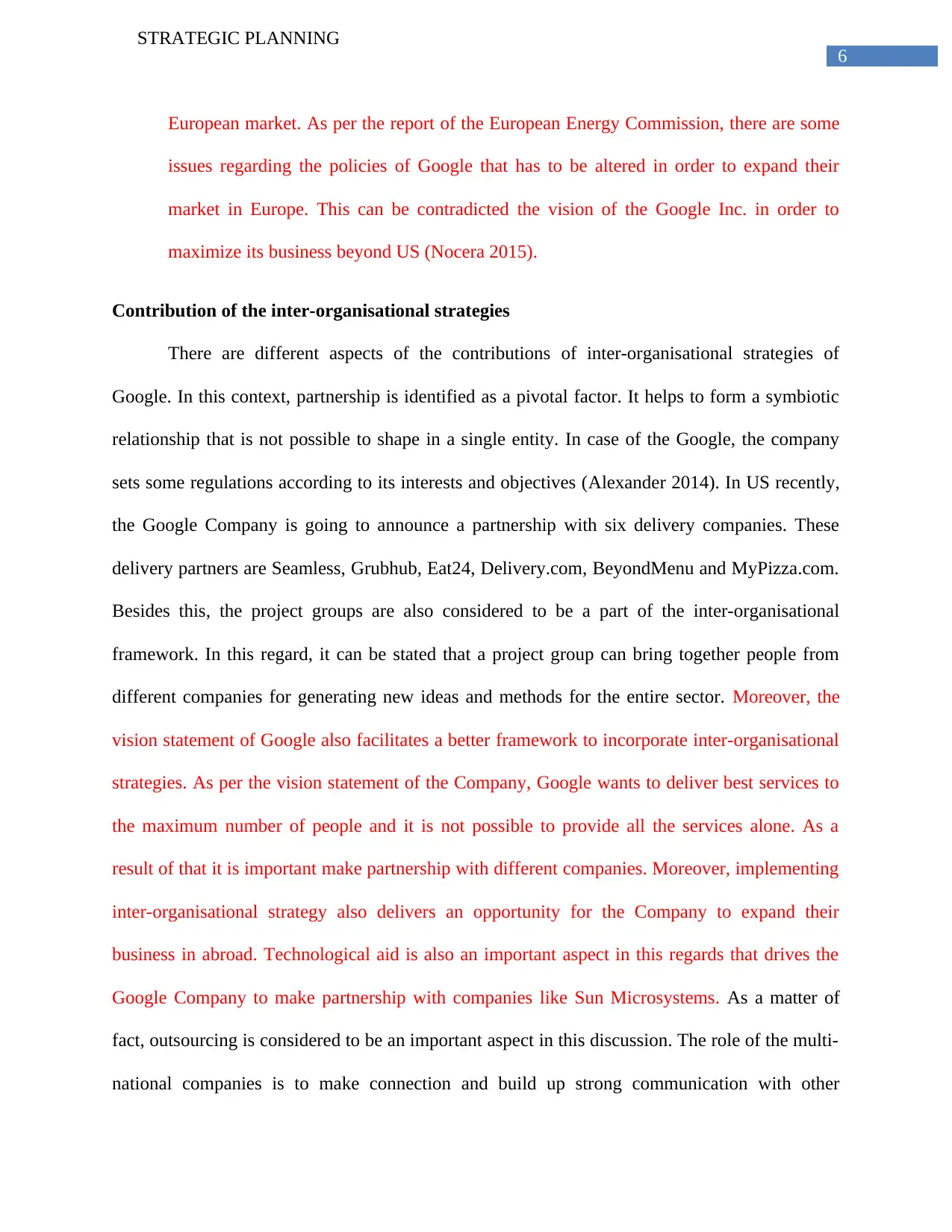
6
STRATEGIC PLANNING
European market. As per the report of the European Energy Commission, there are some
issues regarding the policies of Google that has to be altered in order to expand their
market in Europe. This can be contradicted the vision of the Google Inc. in order to
maximize its business beyond US (Nocera 2015).
Contribution of the inter-organisational strategies
There are different aspects of the contributions of inter-organisational strategies of
Google. In this context, partnership is identified as a pivotal factor. It helps to form a symbiotic
relationship that is not possible to shape in a single entity. In case of the Google, the company
sets some regulations according to its interests and objectives (Alexander 2014). In US recently,
the Google Company is going to announce a partnership with six delivery companies. These
delivery partners are Seamless, Grubhub, Eat24, Delivery.com, BeyondMenu and MyPizza.com.
Besides this, the project groups are also considered to be a part of the inter-organisational
framework. In this regard, it can be stated that a project group can bring together people from
different companies for generating new ideas and methods for the entire sector. Moreover, the
vision statement of Google also facilitates a better framework to incorporate inter-organisational
strategies. As per the vision statement of the Company, Google wants to deliver best services to
the maximum number of people and it is not possible to provide all the services alone. As a
result of that it is important make partnership with different companies. Moreover, implementing
inter-organisational strategy also delivers an opportunity for the Company to expand their
business in abroad. Technological aid is also an important aspect in this regards that drives the
Google Company to make partnership with companies like Sun Microsystems. As a matter of
fact, outsourcing is considered to be an important aspect in this discussion. The role of the multi-
national companies is to make connection and build up strong communication with other
STRATEGIC PLANNING
European market. As per the report of the European Energy Commission, there are some
issues regarding the policies of Google that has to be altered in order to expand their
market in Europe. This can be contradicted the vision of the Google Inc. in order to
maximize its business beyond US (Nocera 2015).
Contribution of the inter-organisational strategies
There are different aspects of the contributions of inter-organisational strategies of
Google. In this context, partnership is identified as a pivotal factor. It helps to form a symbiotic
relationship that is not possible to shape in a single entity. In case of the Google, the company
sets some regulations according to its interests and objectives (Alexander 2014). In US recently,
the Google Company is going to announce a partnership with six delivery companies. These
delivery partners are Seamless, Grubhub, Eat24, Delivery.com, BeyondMenu and MyPizza.com.
Besides this, the project groups are also considered to be a part of the inter-organisational
framework. In this regard, it can be stated that a project group can bring together people from
different companies for generating new ideas and methods for the entire sector. Moreover, the
vision statement of Google also facilitates a better framework to incorporate inter-organisational
strategies. As per the vision statement of the Company, Google wants to deliver best services to
the maximum number of people and it is not possible to provide all the services alone. As a
result of that it is important make partnership with different companies. Moreover, implementing
inter-organisational strategy also delivers an opportunity for the Company to expand their
business in abroad. Technological aid is also an important aspect in this regards that drives the
Google Company to make partnership with companies like Sun Microsystems. As a matter of
fact, outsourcing is considered to be an important aspect in this discussion. The role of the multi-
national companies is to make connection and build up strong communication with other
Paraphrase This Document
Need a fresh take? Get an instant paraphrase of this document with our AI Paraphraser
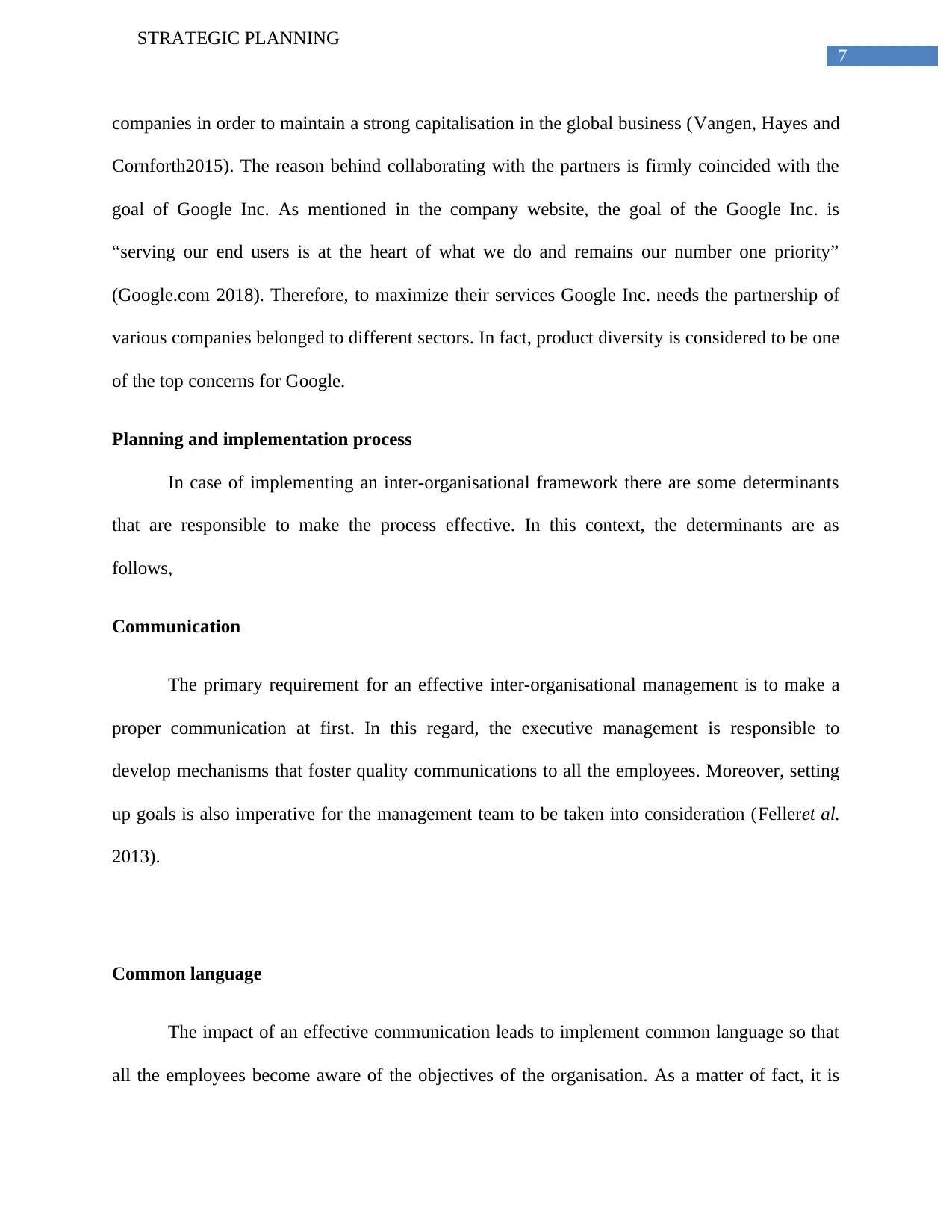
7
STRATEGIC PLANNING
companies in order to maintain a strong capitalisation in the global business (Vangen, Hayes and
Cornforth2015). The reason behind collaborating with the partners is firmly coincided with the
goal of Google Inc. As mentioned in the company website, the goal of the Google Inc. is
“serving our end users is at the heart of what we do and remains our number one priority”
(Google.com 2018). Therefore, to maximize their services Google Inc. needs the partnership of
various companies belonged to different sectors. In fact, product diversity is considered to be one
of the top concerns for Google.
Planning and implementation process
In case of implementing an inter-organisational framework there are some determinants
that are responsible to make the process effective. In this context, the determinants are as
follows,
Communication
The primary requirement for an effective inter-organisational management is to make a
proper communication at first. In this regard, the executive management is responsible to
develop mechanisms that foster quality communications to all the employees. Moreover, setting
up goals is also imperative for the management team to be taken into consideration (Felleret al.
2013).
Common language
The impact of an effective communication leads to implement common language so that
all the employees become aware of the objectives of the organisation. As a matter of fact, it is
STRATEGIC PLANNING
companies in order to maintain a strong capitalisation in the global business (Vangen, Hayes and
Cornforth2015). The reason behind collaborating with the partners is firmly coincided with the
goal of Google Inc. As mentioned in the company website, the goal of the Google Inc. is
“serving our end users is at the heart of what we do and remains our number one priority”
(Google.com 2018). Therefore, to maximize their services Google Inc. needs the partnership of
various companies belonged to different sectors. In fact, product diversity is considered to be one
of the top concerns for Google.
Planning and implementation process
In case of implementing an inter-organisational framework there are some determinants
that are responsible to make the process effective. In this context, the determinants are as
follows,
Communication
The primary requirement for an effective inter-organisational management is to make a
proper communication at first. In this regard, the executive management is responsible to
develop mechanisms that foster quality communications to all the employees. Moreover, setting
up goals is also imperative for the management team to be taken into consideration (Felleret al.
2013).
Common language
The impact of an effective communication leads to implement common language so that
all the employees become aware of the objectives of the organisation. As a matter of fact, it is
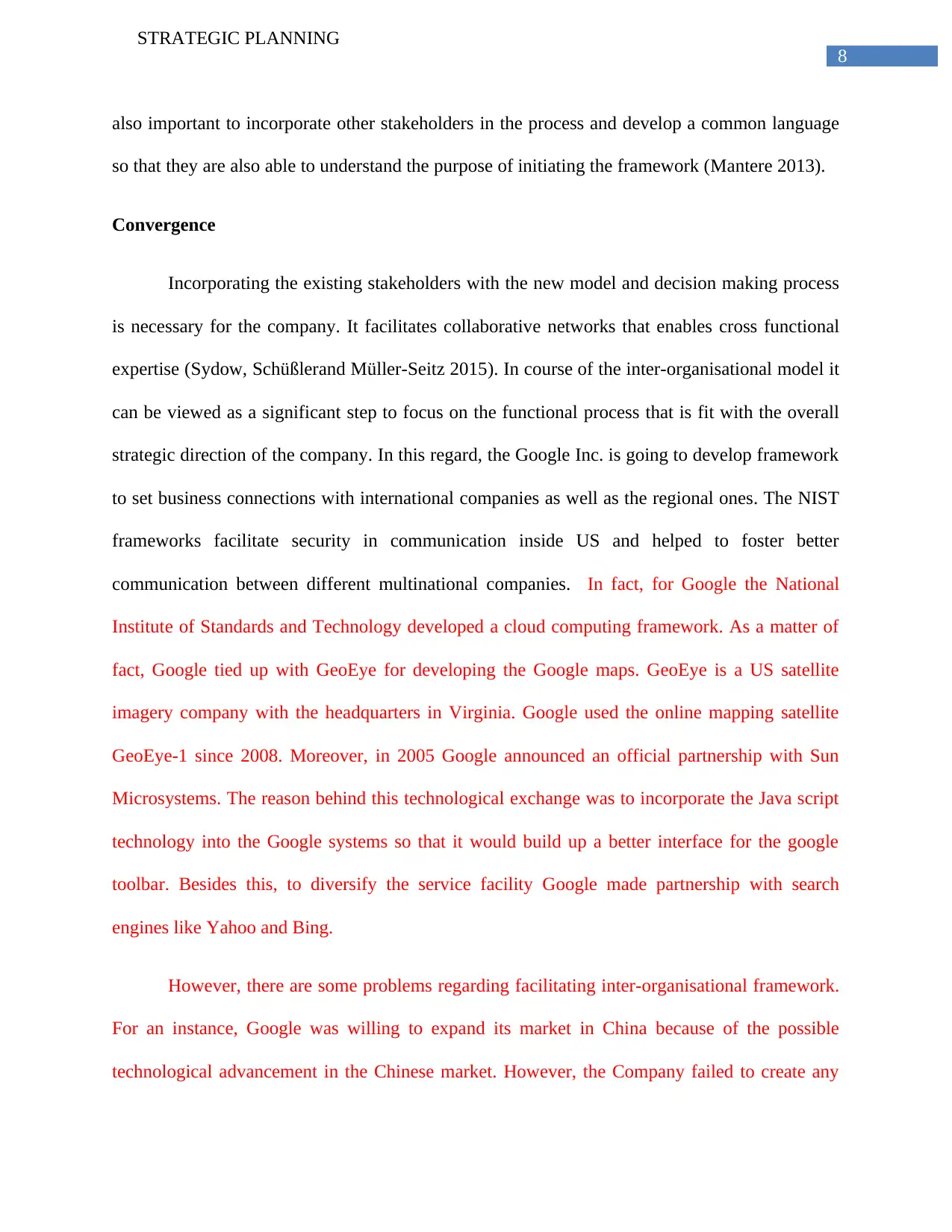
8
STRATEGIC PLANNING
also important to incorporate other stakeholders in the process and develop a common language
so that they are also able to understand the purpose of initiating the framework (Mantere 2013).
Convergence
Incorporating the existing stakeholders with the new model and decision making process
is necessary for the company. It facilitates collaborative networks that enables cross functional
expertise (Sydow, Schüßlerand Müller-Seitz 2015). In course of the inter-organisational model it
can be viewed as a significant step to focus on the functional process that is fit with the overall
strategic direction of the company. In this regard, the Google Inc. is going to develop framework
to set business connections with international companies as well as the regional ones. The NIST
frameworks facilitate security in communication inside US and helped to foster better
communication between different multinational companies. In fact, for Google the National
Institute of Standards and Technology developed a cloud computing framework. As a matter of
fact, Google tied up with GeoEye for developing the Google maps. GeoEye is a US satellite
imagery company with the headquarters in Virginia. Google used the online mapping satellite
GeoEye-1 since 2008. Moreover, in 2005 Google announced an official partnership with Sun
Microsystems. The reason behind this technological exchange was to incorporate the Java script
technology into the Google systems so that it would build up a better interface for the google
toolbar. Besides this, to diversify the service facility Google made partnership with search
engines like Yahoo and Bing.
However, there are some problems regarding facilitating inter-organisational framework.
For an instance, Google was willing to expand its market in China because of the possible
technological advancement in the Chinese market. However, the Company failed to create any
STRATEGIC PLANNING
also important to incorporate other stakeholders in the process and develop a common language
so that they are also able to understand the purpose of initiating the framework (Mantere 2013).
Convergence
Incorporating the existing stakeholders with the new model and decision making process
is necessary for the company. It facilitates collaborative networks that enables cross functional
expertise (Sydow, Schüßlerand Müller-Seitz 2015). In course of the inter-organisational model it
can be viewed as a significant step to focus on the functional process that is fit with the overall
strategic direction of the company. In this regard, the Google Inc. is going to develop framework
to set business connections with international companies as well as the regional ones. The NIST
frameworks facilitate security in communication inside US and helped to foster better
communication between different multinational companies. In fact, for Google the National
Institute of Standards and Technology developed a cloud computing framework. As a matter of
fact, Google tied up with GeoEye for developing the Google maps. GeoEye is a US satellite
imagery company with the headquarters in Virginia. Google used the online mapping satellite
GeoEye-1 since 2008. Moreover, in 2005 Google announced an official partnership with Sun
Microsystems. The reason behind this technological exchange was to incorporate the Java script
technology into the Google systems so that it would build up a better interface for the google
toolbar. Besides this, to diversify the service facility Google made partnership with search
engines like Yahoo and Bing.
However, there are some problems regarding facilitating inter-organisational framework.
For an instance, Google was willing to expand its market in China because of the possible
technological advancement in the Chinese market. However, the Company failed to create any
⊘ This is a preview!⊘
Do you want full access?
Subscribe today to unlock all pages.

Trusted by 1+ million students worldwide
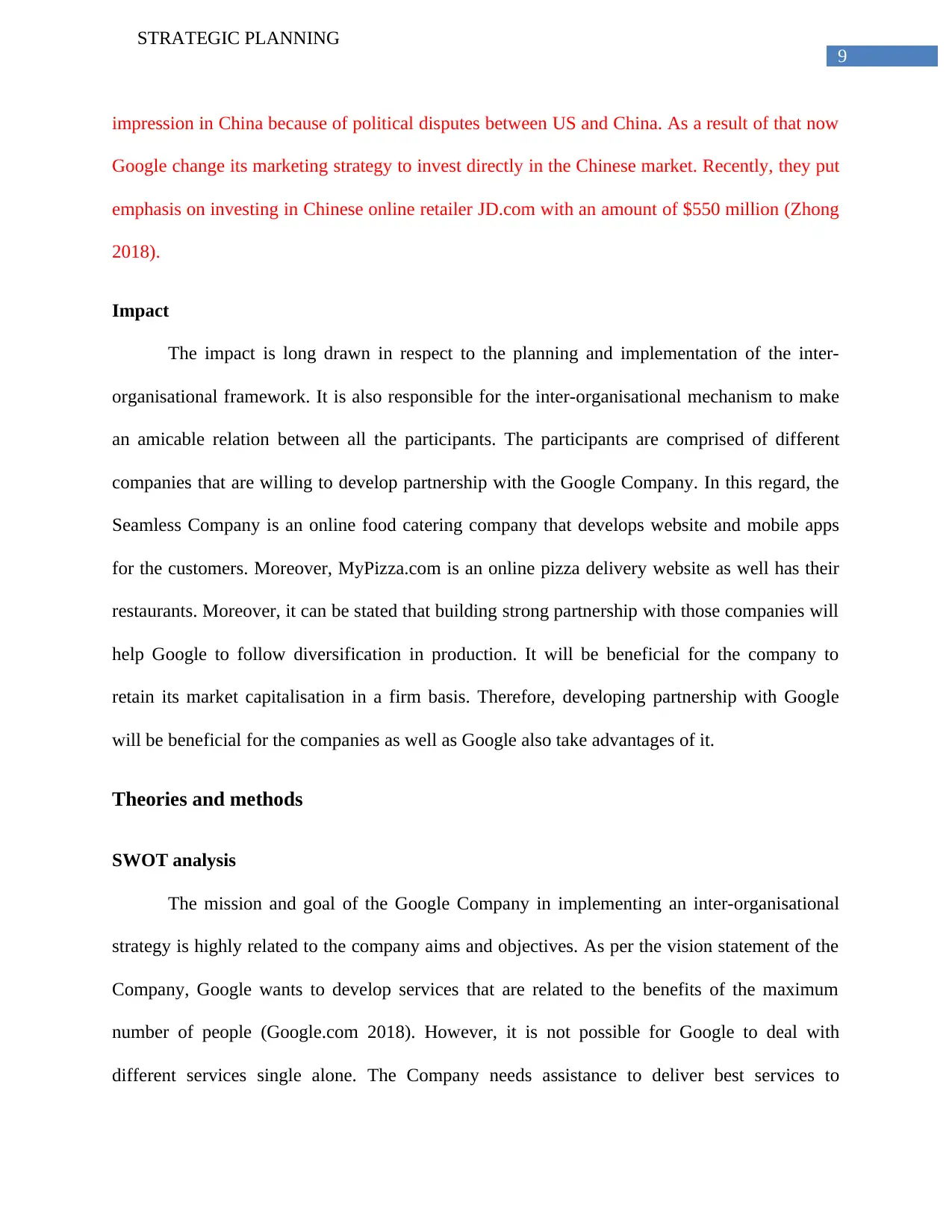
9
STRATEGIC PLANNING
impression in China because of political disputes between US and China. As a result of that now
Google change its marketing strategy to invest directly in the Chinese market. Recently, they put
emphasis on investing in Chinese online retailer JD.com with an amount of $550 million (Zhong
2018).
Impact
The impact is long drawn in respect to the planning and implementation of the inter-
organisational framework. It is also responsible for the inter-organisational mechanism to make
an amicable relation between all the participants. The participants are comprised of different
companies that are willing to develop partnership with the Google Company. In this regard, the
Seamless Company is an online food catering company that develops website and mobile apps
for the customers. Moreover, MyPizza.com is an online pizza delivery website as well has their
restaurants. Moreover, it can be stated that building strong partnership with those companies will
help Google to follow diversification in production. It will be beneficial for the company to
retain its market capitalisation in a firm basis. Therefore, developing partnership with Google
will be beneficial for the companies as well as Google also take advantages of it.
Theories and methods
SWOT analysis
The mission and goal of the Google Company in implementing an inter-organisational
strategy is highly related to the company aims and objectives. As per the vision statement of the
Company, Google wants to develop services that are related to the benefits of the maximum
number of people (Google.com 2018). However, it is not possible for Google to deal with
different services single alone. The Company needs assistance to deliver best services to
STRATEGIC PLANNING
impression in China because of political disputes between US and China. As a result of that now
Google change its marketing strategy to invest directly in the Chinese market. Recently, they put
emphasis on investing in Chinese online retailer JD.com with an amount of $550 million (Zhong
2018).
Impact
The impact is long drawn in respect to the planning and implementation of the inter-
organisational framework. It is also responsible for the inter-organisational mechanism to make
an amicable relation between all the participants. The participants are comprised of different
companies that are willing to develop partnership with the Google Company. In this regard, the
Seamless Company is an online food catering company that develops website and mobile apps
for the customers. Moreover, MyPizza.com is an online pizza delivery website as well has their
restaurants. Moreover, it can be stated that building strong partnership with those companies will
help Google to follow diversification in production. It will be beneficial for the company to
retain its market capitalisation in a firm basis. Therefore, developing partnership with Google
will be beneficial for the companies as well as Google also take advantages of it.
Theories and methods
SWOT analysis
The mission and goal of the Google Company in implementing an inter-organisational
strategy is highly related to the company aims and objectives. As per the vision statement of the
Company, Google wants to develop services that are related to the benefits of the maximum
number of people (Google.com 2018). However, it is not possible for Google to deal with
different services single alone. The Company needs assistance to deliver best services to
Paraphrase This Document
Need a fresh take? Get an instant paraphrase of this document with our AI Paraphraser
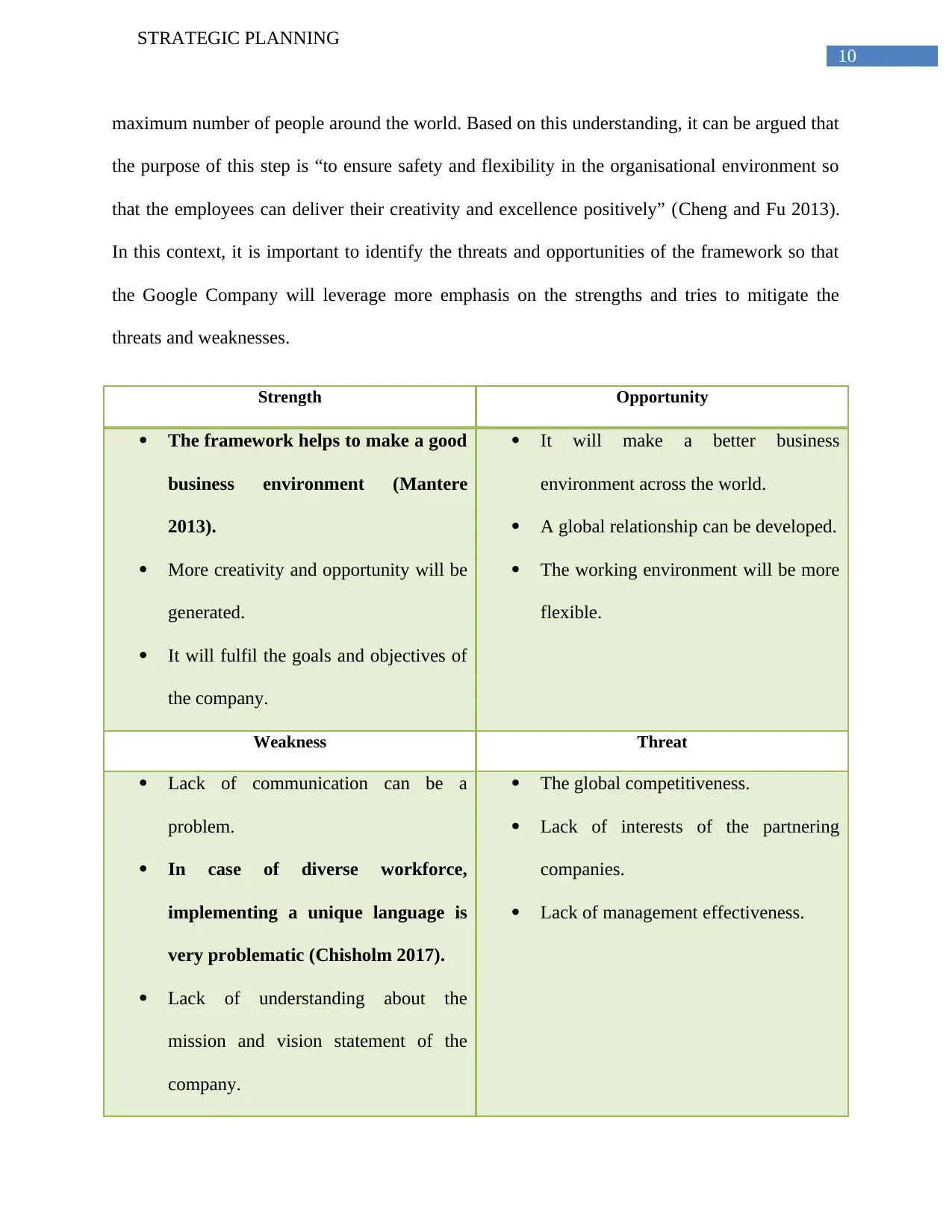
10
STRATEGIC PLANNING
maximum number of people around the world. Based on this understanding, it can be argued that
the purpose of this step is “to ensure safety and flexibility in the organisational environment so
that the employees can deliver their creativity and excellence positively” (Cheng and Fu 2013).
In this context, it is important to identify the threats and opportunities of the framework so that
the Google Company will leverage more emphasis on the strengths and tries to mitigate the
threats and weaknesses.
Strength Opportunity
The framework helps to make a good
business environment (Mantere
2013).
More creativity and opportunity will be
generated.
It will fulfil the goals and objectives of
the company.
It will make a better business
environment across the world.
A global relationship can be developed.
The working environment will be more
flexible.
Weakness Threat
Lack of communication can be a
problem.
In case of diverse workforce,
implementing a unique language is
very problematic (Chisholm 2017).
Lack of understanding about the
mission and vision statement of the
company.
The global competitiveness.
Lack of interests of the partnering
companies.
Lack of management effectiveness.
STRATEGIC PLANNING
maximum number of people around the world. Based on this understanding, it can be argued that
the purpose of this step is “to ensure safety and flexibility in the organisational environment so
that the employees can deliver their creativity and excellence positively” (Cheng and Fu 2013).
In this context, it is important to identify the threats and opportunities of the framework so that
the Google Company will leverage more emphasis on the strengths and tries to mitigate the
threats and weaknesses.
Strength Opportunity
The framework helps to make a good
business environment (Mantere
2013).
More creativity and opportunity will be
generated.
It will fulfil the goals and objectives of
the company.
It will make a better business
environment across the world.
A global relationship can be developed.
The working environment will be more
flexible.
Weakness Threat
Lack of communication can be a
problem.
In case of diverse workforce,
implementing a unique language is
very problematic (Chisholm 2017).
Lack of understanding about the
mission and vision statement of the
company.
The global competitiveness.
Lack of interests of the partnering
companies.
Lack of management effectiveness.
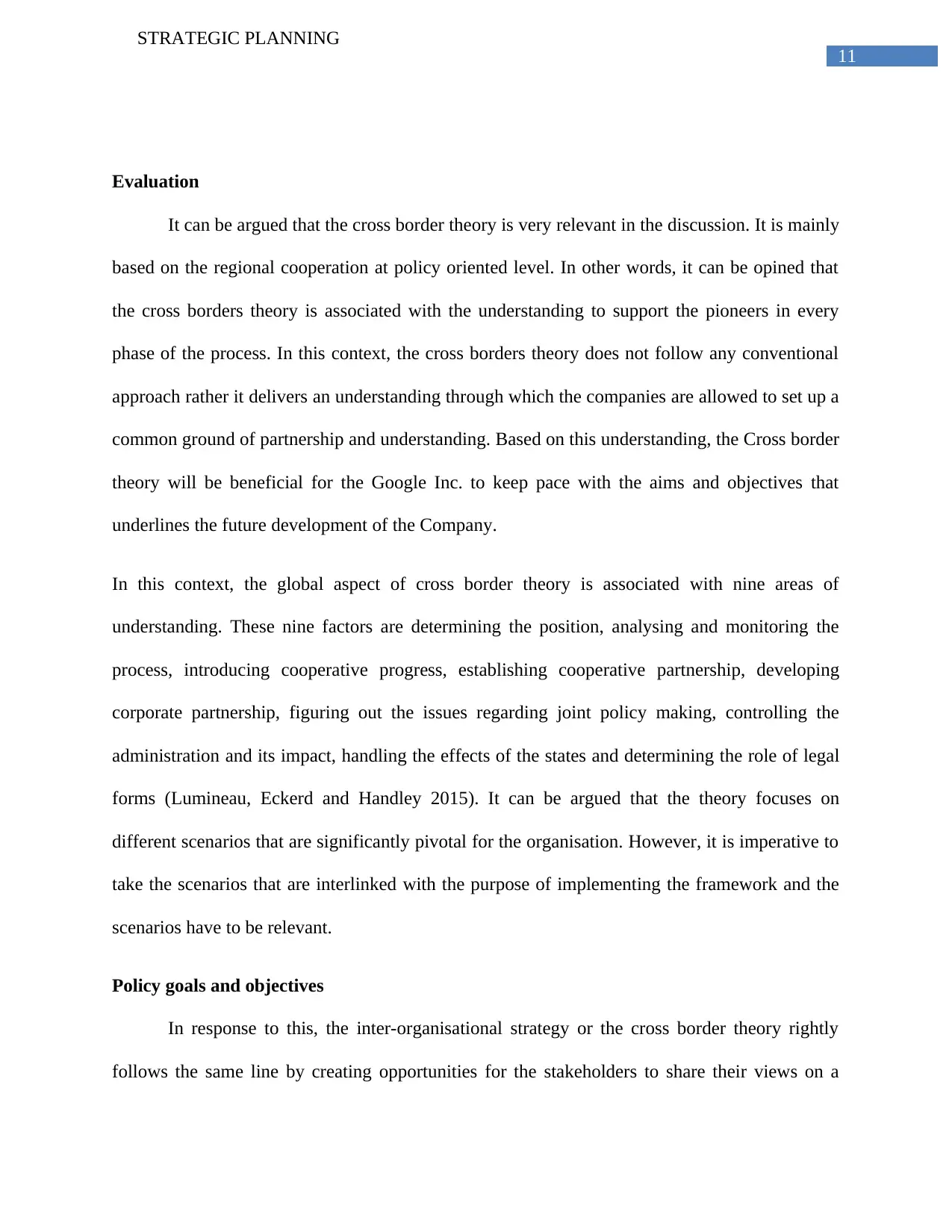
11
STRATEGIC PLANNING
Evaluation
It can be argued that the cross border theory is very relevant in the discussion. It is mainly
based on the regional cooperation at policy oriented level. In other words, it can be opined that
the cross borders theory is associated with the understanding to support the pioneers in every
phase of the process. In this context, the cross borders theory does not follow any conventional
approach rather it delivers an understanding through which the companies are allowed to set up a
common ground of partnership and understanding. Based on this understanding, the Cross border
theory will be beneficial for the Google Inc. to keep pace with the aims and objectives that
underlines the future development of the Company.
In this context, the global aspect of cross border theory is associated with nine areas of
understanding. These nine factors are determining the position, analysing and monitoring the
process, introducing cooperative progress, establishing cooperative partnership, developing
corporate partnership, figuring out the issues regarding joint policy making, controlling the
administration and its impact, handling the effects of the states and determining the role of legal
forms (Lumineau, Eckerd and Handley 2015). It can be argued that the theory focuses on
different scenarios that are significantly pivotal for the organisation. However, it is imperative to
take the scenarios that are interlinked with the purpose of implementing the framework and the
scenarios have to be relevant.
Policy goals and objectives
In response to this, the inter-organisational strategy or the cross border theory rightly
follows the same line by creating opportunities for the stakeholders to share their views on a
STRATEGIC PLANNING
Evaluation
It can be argued that the cross border theory is very relevant in the discussion. It is mainly
based on the regional cooperation at policy oriented level. In other words, it can be opined that
the cross borders theory is associated with the understanding to support the pioneers in every
phase of the process. In this context, the cross borders theory does not follow any conventional
approach rather it delivers an understanding through which the companies are allowed to set up a
common ground of partnership and understanding. Based on this understanding, the Cross border
theory will be beneficial for the Google Inc. to keep pace with the aims and objectives that
underlines the future development of the Company.
In this context, the global aspect of cross border theory is associated with nine areas of
understanding. These nine factors are determining the position, analysing and monitoring the
process, introducing cooperative progress, establishing cooperative partnership, developing
corporate partnership, figuring out the issues regarding joint policy making, controlling the
administration and its impact, handling the effects of the states and determining the role of legal
forms (Lumineau, Eckerd and Handley 2015). It can be argued that the theory focuses on
different scenarios that are significantly pivotal for the organisation. However, it is imperative to
take the scenarios that are interlinked with the purpose of implementing the framework and the
scenarios have to be relevant.
Policy goals and objectives
In response to this, the inter-organisational strategy or the cross border theory rightly
follows the same line by creating opportunities for the stakeholders to share their views on a
⊘ This is a preview!⊘
Do you want full access?
Subscribe today to unlock all pages.

Trusted by 1+ million students worldwide
1 out of 20
Related Documents
Your All-in-One AI-Powered Toolkit for Academic Success.
+13062052269
info@desklib.com
Available 24*7 on WhatsApp / Email
![[object Object]](/_next/static/media/star-bottom.7253800d.svg)
Unlock your academic potential
Copyright © 2020–2025 A2Z Services. All Rights Reserved. Developed and managed by ZUCOL.





